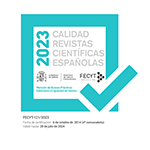Análisis del desarrollo curricular de la Educación Plástica y Visual en Educación Primaria: Estudio comparado de Andalucía y Castilla y León
Resumen
La Educación Plástica y Visual aparece en Educación Primaria para permitir al alumnado crear, construir, analizar, reflexionar, comunicar y conectar a través del arte, desarrollando capacidades, habilidades y actitudes que fomentan la creatividad, el análisis crítico y el lenguaje en todas sus vertientes. El objetivo de este trabajo es analizar y comparar los desarrollos curriculares de dos administraciones educativas identificando sus fortalezas y debilidades, y realizar propuestas de mejora para futuros desarrollos curriculares. Como método se ha realizado un análisis comparativo de las normativas curriculares, definiéndose una estructura común y elementos diferenciadores a nivel cuantitativo y cualitativo. Los resultados muestran la existencia de diferencias significativas, en carga horaria, número y redacción de criterios de evaluación, así como en número y redacción de saberes o contenidos. Se observa que la administración educativa con mayor puntuación en evaluación PISA, presenta un desarrollo más completo a través de un currículo más simple, dedica más tiempo al área, evalúa con criterios más claros y establece más referencias directas a competencias como la lingüística. En conclusión, el análisis realizado pone de manifiesto que los desarrollos son dispares y que deben apuntarse recomendaciones para cohesionar el currículo de la Educación Plástica y Visual para su mejora.
Descargas
Licencia
La revista Arte, Individuo y Sociedad, para fomentar el intercambio global del conocimiento, facilita el acceso sin restricciones a sus contenidos desde el momento de su publicación en la presente edición electrónica, y por eso es una revista de acceso abierto. Los originales publicados en esta revista son propiedad de la Universidad Complutense de Madrid y es obligatorio citar su procedencia en cualquier reproducción total o parcial. Todos los contenidos se distribuyen bajo una licencia de uso y distribución Creative Commons Reconocimiento 4.0 (CC BY 4.0). Esta circunstancia ha de hacerse constar expresamente de esta forma cuando sea necesario. Puede consultar la versión informativa y el texto legal de la licencia.










